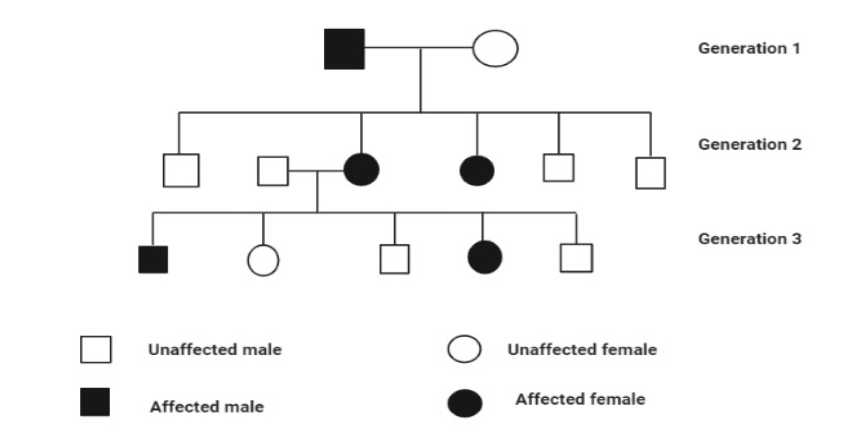
Given below is a pedigree chart showing the inheritance of a certain linked trait in humans.

The trait traced in the above pedigree chart is
a. Dominant X linked
b. Recessive X linked
c. Dominant Y linked
d. Recessive Y linked

Answer
484.2k+ views
Hint: According to the given pedigree chart it can be seen that the father is diseased and the mother is normal. Then in the second generation, all the sons are normal but the daughters are diseased. In the third generation the progeny i.e. one daughter and one son developed from the diseased daughter from the second generation. Thus, from this pattern, it is visible that the trait traced is the dominant X-linked.
Complete answer:
• In the above pedigree chart, it can be seen in the first generation of parents that the father is diseased and the mother is normal.
• In the second generation, it can be seen that all the sons are normal and the daughters are diseased which means that the disease has been inherited from the deceased father to the daughters. From this, it is clear that trait is sex-linked. If the father inherited the disease from the son also then the trait would have been autosomal.
• Next, from this pedigree chart, it is clear that only daughters are diseased not the sons, therefore the trait is X- linked because the father transmitted his X- chromosomes to the daughters
• In generation two only daughters are affected this means that the mother in generation one was the carrier of the particular trait. But in generation 3 both son and daughter are affected this means that the trait is the dominant X linked as it is seen in both males and females and also occurring in every generation.
Hence, the correct answer is option (A).
Note: The chart given above is called the pedigree chart. The pedigree is the diagram to show the ancestral relationship and transmission of characters over several generations in the human family. The traits inherited from parents to progeny can either be X linked or Y linked and further, it can be dominant or recessive.
Complete answer:
• In the above pedigree chart, it can be seen in the first generation of parents that the father is diseased and the mother is normal.
• In the second generation, it can be seen that all the sons are normal and the daughters are diseased which means that the disease has been inherited from the deceased father to the daughters. From this, it is clear that trait is sex-linked. If the father inherited the disease from the son also then the trait would have been autosomal.
• Next, from this pedigree chart, it is clear that only daughters are diseased not the sons, therefore the trait is X- linked because the father transmitted his X- chromosomes to the daughters
• In generation two only daughters are affected this means that the mother in generation one was the carrier of the particular trait. But in generation 3 both son and daughter are affected this means that the trait is the dominant X linked as it is seen in both males and females and also occurring in every generation.
Hence, the correct answer is option (A).
Note: The chart given above is called the pedigree chart. The pedigree is the diagram to show the ancestral relationship and transmission of characters over several generations in the human family. The traits inherited from parents to progeny can either be X linked or Y linked and further, it can be dominant or recessive.
Recently Updated Pages
Master Class 12 Business Studies: Engaging Questions & Answers for Success

Master Class 12 English: Engaging Questions & Answers for Success

Master Class 12 Social Science: Engaging Questions & Answers for Success

Master Class 12 Chemistry: Engaging Questions & Answers for Success

Class 12 Question and Answer - Your Ultimate Solutions Guide

Master Class 11 Economics: Engaging Questions & Answers for Success

Trending doubts
Draw a labelled sketch of the human eye class 12 physics CBSE

a Tabulate the differences in the characteristics of class 12 chemistry CBSE

Which one of the following is a true fish A Jellyfish class 12 biology CBSE

Why is the cell called the structural and functional class 12 biology CBSE

Differentiate between homogeneous and heterogeneous class 12 chemistry CBSE

Write the difference between solid liquid and gas class 12 chemistry CBSE




